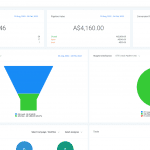There’s a lot of talk about how all businesses “should” have a blog.
You’ve likely heard all the reasons why, such as it being good for SEO, establishing you as an authority in your field, staying top of mind with your email list, yadda yadda.
But rarely do we see how blogging translates into real world results.
Take a look at the screenshot below. This is from one of our clients’ HubSpot dashboards. It shows the results of publishing a weekly blog post, week in, week out, for a year. (Note this is just for the blog section of the website, NOT for the entire website, which had many more visits than this over the same period, which you can find out more about in our full case study.)

As you can see from the graph, the net result of publishing a weekly blog post over the course of a year was 25,822 visits, 10.5% of which went on to become contacts, or leads. These results are for a boutique home builder based in country Victoria.
When we break down the sources of those visits, we can see that more than half came from email marketing. This is thanks to a “RSS to email” feed which sends the entire email list an email each time a new post is published.
Traffic Sources Explained
Digging further into the traffic sources, we can see that 3,432 visits came from organic search. This is more than 3000 visitors (80 of whom became leads) they would not otherwise have had.
An interesting number in this picture is the large amount of “direct” traffic. Even more interesting is the inordinately high conversion rate of direct traffic into contacts, at more than 20x the conversion rate of organic traffic. Let’s take a quick look at those two numbers…
Direct traffic is traffic that falls into a couple of categories:
- People who type your URL directly into their browser address bar (note this includes people who have visited your site previously typing the first letter of your site or business name into the address bar and choosing to revisit via the prefilled dropdown suggestions given by the browser).
- Traffic that cannot be accounted for elsewhere by the referral URL. For example, this could be someone visiting from an email client like Gmail (if there is no tracking on the link in the email), or clicking a link in a PDF document, or organic search that has been incorrectly segmented by Google. (Check out this Groupon experiment where as much as 60% of direct traffic was actually organic search.)
So why is this direct traffic converting so much better than the other sources? My belief is that these are mostly repeat visitors, and they’re returning because they are interested in the product. The first visit was just to look around and absorb information, but this second visit means they liked what they saw the first time round and are now ready to take the next step and sign up for a content offer or make an enquiry.
Main Takeaways from These Stats
- Blogging works to drive traffic to your website and move people along the buyer journey
- Blogging has a “snowball” effect because you are building permanent resources that will always be there (unlike something like PPC where you stop getting traffic when you stop paying money)
Perhaps blogging’s biggest benefit is that it is a great way to educate and engage existing leads (and customers, depending on your industry) - Just writing isn’t enough – you need to also promote the blog posts properly, and make sure your posts are optimised for conversion by having clear “next steps” such as a lead magnet or free checklist
- Blogging takes time – you won’t have immediate success, but if you stick at it you will undoubtedly experience a very strong ROI on the time and effort (and/or money) you invest in it
Bottom Line on Blogging for Business
Blogging for business works, as you can see from these results. By sticking at it, focusing on promotion as much as publication, and using the blog to answer real customer questions, you’ll build a resource that pays for itself many times over.
- How Videos Can Be Used in Email Marketing for More Engagement - April 4, 2022
- Attention Home Builders: Here’s How to Educate, Engage and Win Over Potential Customers - October 19, 2020
- The Best Digital Marketing Framework for High Ticket Businesses - September 14, 2020







Great stuff Damien, awesome example of content delivering results! Stats seem to support you were creating content that was really valued by prospects, as the people who keep coming back, emails and direct traffic, were the ones converting into customers.
Hey Paul, yeah it goes to show how important it is to keep connecting with your database. Thanks for the comment – hope you’re going well!